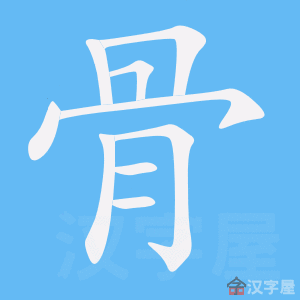|
懒骨头
lǎn gǔ tou
|
lazybones;
beanbag
|
|
瘦骨嶙峋
shòu gǔ lín xún
|
skinny; emaciated (idiom)
|
|
脊梁骨
jǐ liang gǔ
|
backbone
|
|
骨膜
gǔ mó
|
periosteum (membrane covering bone)
|
|
髋骨
kuān gǔ
|
hip bone
|
|
外骨骼
wài gǔ gé
|
exoskeleton (the carapace of insects, crabs etc)
|
|
骨科
gǔ kē
|
orthopedics;
orthopedic surgery
|
|
髂骨
qià gǔ
|
ilium (the large flat bone of the pelvic girdle)
|
|
龙骨
lóng gǔ
|
keel;
dragon bones (ancient bones used in TCM)
|
|
肱骨
gōng gǔ
|
humerus
|
|
骨质疏松症
gǔ zhì shū sōng zhèng
|
osteoporosis
|
|
骶骨
dǐ gǔ
|
sacrum (anatomy);
bone forming the base of the spinal column
|
|
软骨病
ruǎn gǔ bìng
|
chondropathy (medicine)
|
|
骨粉
gǔ fěn
|
bone meal
|
|
贱骨头
jiàn gǔ tou
|
miserable wretch;
contemptible individual
|
|
踝骨
huái gǔ
|
ankle bone;
ankle
|
|
耻骨
chǐ gǔ
|
pubis;
pubic bone
|
|
甲骨文
jiǎ gǔ wén
|
oracle script;
oracle bone inscriptions (an early form of Chinese script)
|
|
白骨
bái gǔ
|
bones of the dead
|
|
胯骨
kuà gǔ
|
hip bone
|
|
骨化
gǔ huà
|
to ossify;
ossification
|
|
坐骨
zuò gǔ
|
ischium
|
|
砧骨
zhēn gǔ
|
incus or anvil bone of middle ear, passing sound vibration from malleus hammer bone to stapes stirrup bone
|
|
蝶骨
dié gǔ
|
sphenoid bone (front of the temple)
|
|
骨刺
gǔ cì
|
spur;
bony outgrowth
|

